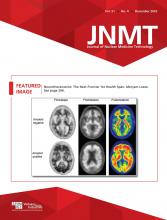Abstract
Metastases to the female genital tract are rare, especially from extragenital primaries. The most common extragenital sites associated with genital metastasis are the gastrointestinal tract (37.6%) followed by the breast (34.9%). It is crucial to differentiate primary from metastatic involvement of the uterus for appropriate patient management. We present one such case of endometrial metastasis in a patient who presented clinically with abnormal uterine bleeding and was diagnosed with primary breast cancer via 18F-FDG PET/CT.
Metastases to the female genital tract from extragenital primaries are rarely encountered. The uterus is involved in less than 5% of cases of genital metastasis from an extragenital organ (1,2). The metastasis may present with abnormal uterine bleeding, mimicking a primary uterine malignancy on histopathology. It is crucial to differentiate a uterine metastasis from a uterine primary for appropriate management (3). We present one such case of suspected endometrial malignancy in which the patient presented with abnormal uterine bleeding and was diagnosed as having a primary breast malignancy via 18F-FDG PET/CT.
CASE REPORT
A 42-y-old woman presented with abnormal uterine bleeding for 2 mo. Contrast-enhanced CT of the abdomen and pelvis was performed and revealed a bulky uterus with a hypoenhancing endomyometrium and lytic bone lesions, suggestive of a malignant uterine pathology with bony metastasis. MRI of the pelvis revealed a bulky uterus with a thickened uterine wall that had irregular margins (involving > 50%) and no extraserosal spread. Core-needle biopsy with histopathologic examination was consistent with poorly differentiated adenocarcinoma. Immunohistochemistry was positive for pan-cytokeratin and estrogen receptor–mimicking primary endometroid carcinoma.
18F-FDG PET/CT revealed a tracer-avid soft-tissue lesion in the left breast, as well as left axillary lymphadenopathy with widespread metastatic disease including the endometrial lesion, favoring a finding of breast primary with endometrial metastasis rather than primary endometrial cancer with breast metastasis (Fig. 1). Tru-Cut (C.R. Bard, Inc.) biopsy of the left breast lesion revealed triple-positive invasive breast cancer, no special type, grade 3. After this endometrial biopsy, block review of the biopsy sample with immunohistochemistry was performed, revealing strong and diffuse immunopositivity for pan-cytokeratin, estrogen receptor, cytokeratin 7, and GATA3 but negative staining for PAX8—findings that were overall consistent with metastatic adenocarcinoma from a breast primary. Thus, the patient was started on a taxane–platinum combination chemotherapy along with targeted therapy with trastuzumab. Follow-up 18F-FDG PET/CT after 5 cycles of treatment revealed a partial response to therapy, with complete resolution of the endometrial lesion (Fig. 2).
18F-FDG PET/CT of 42-y-old woman with suspected carcinoma of endometrium. (A) PET maximum-intensity projection showing multiple 18F-FDG–avid lesions. (B) Transaxial images showing lobulated soft-tissue lesion with spiculated margins involving upper inner quadrant of left breast (arrow) and (C) 18F-FDG–avid left interpectoral lymph nodes (arrow), suggestive of breast primary with nodal metastasis. (D and E) 18F-FDG–avid hypodense lesion involving body of uterus (arrow in E) with bilaterally 18F-FDG–avid external iliac lymph nodes (arrow in D), overall favoring breast primary with endometrial metastasis rather than primary endometrial cancer. (F and G) 18F-FDG–avid lytic skeletal lesions involving L3 vertebra (arrow in F) and sternum (arrow in G), suggestive of metastatic involvement.
Follow-up 18F-FDG PET/CT of same patient as in Figure 1, after 5 cycles of chemotherapy. (A) PET maximum-intensity projection showing metabolic activity regression of most of the previous lesions. (B and C) Transaxial images showing regression in size and metabolic activity of left breast mass (arrow) and resolution of left interpectoral lymph node. (D and E) Resolution of hypodense lesion involving body of uterus, and regression in size and metabolic activity of bilateral external iliac lymph nodes. (F and G) Regression in metabolic activity with increase in sclerosis in skeletal lesions (arrow). Scan findings are suggestive of favorable response to therapy.
DISCUSSION
Metastasis to gynecologic organs from an extragenital malignancy is rare, the most common primary sites being the gastrointestinal tract (37.6%) and, rarely, the breast. Metastasis from an extrapelvic malignancy often involves the ovary (75%), and the uterus is rarely involved (34.9%) (2,4).
The diagnosis of uterine metastasis can be clinically challenging because of its infrequent occurrence and clinical similarities to a primary uterine malignancy. Both present with abnormal uterine bleeding; share similar features on imaging such as ultrasonography, contrast-enhanced CT, and MRI; and show similar histopathology features. Moreover, on immunohistochemistry, both show hormonal receptor immunoreactivity as seen in the present case (5).
Differentiating primary from metastatic uterine involvement is crucial for appropriate management. This differentiation requires a detailed history, a vigilant histopathologic examination, use of appropriate immunohistochemistry markers, and correlation with histology at other sites suspected of harboring possible primaries. Breast cancer metastases are usually positive for hormonal receptors, human epidermal growth factor receptor 2, cytokeratin 7, GATA3, gross cystic disease fluid protein 15, and mammaglobin and negative for PAX8 on immunohistochemistry (5). In the present case, use of 18F-FDG PET/CT raised the possibility that, rather than a primary uterine malignancy, there was metastatic involvement of the uterus, which was confirmed with use of more specific immunohistochemistry markers for breast cancer such as GATA3 positivity and PAX8 negativity, along with other supporting histopathologic features (2,5).
CONCLUSION
Uterine metastasis, though uncommon, must be considered in patients presenting with abnormal uterine bleeding, especially patients with known treated or untreated primaries, particularly breast, stomach, and colorectal cancers, as well as cancers with an atypical histology or bimorphic features. Appropriate immunohistochemistry should be used with special caution in cases of known or suspected primary breast cancer.
DISCLOSURE
No potential conflict of interest relevant to this article was reported.
Footnotes
Published online Sep. 12, 2023.
REFERENCES
- Received for publication June 22, 2023.
- Revision received August 18, 2023.









